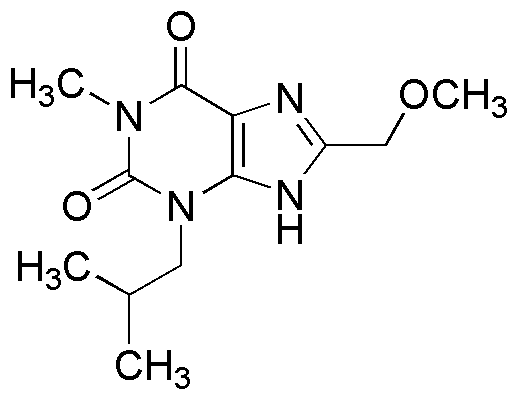8-Methoxymethyl-3-isobutyl-1-methylxanthine is widely utilized in research focused on:
- Pharmaceutical Development: This compound is often explored for its potential as a therapeutic agent in treating respiratory diseases, particularly due to its ability to inhibit phosphodiesterase, which can enhance airway function.
- Caffeine Research: It serves as a valuable tool in studying the effects of caffeine and related compounds on human physiology, helping researchers understand their mechanisms of action and potential health benefits.
- Neuroscience Studies: The compound is used in neuropharmacology to investigate its effects on cognitive functions and mood, providing insights into how similar xanthine derivatives can influence brain activity.
- Cardiovascular Research: Its role in modulating vascular smooth muscle relaxation makes it significant in cardiovascular studies, where it can help in understanding blood flow regulation and potential treatments for hypertension.
- Drug Interaction Studies: This chemical is also employed to assess interactions with other medications, particularly in understanding how it can affect the metabolism and efficacy of various drugs.
Informations générales
Propriétés
Sécurité et réglementation
Applications
8-Methoxymethyl-3-isobutyl-1-methylxanthine is widely utilized in research focused on:
- Pharmaceutical Development: This compound is often explored for its potential as a therapeutic agent in treating respiratory diseases, particularly due to its ability to inhibit phosphodiesterase, which can enhance airway function.
- Caffeine Research: It serves as a valuable tool in studying the effects of caffeine and related compounds on human physiology, helping researchers understand their mechanisms of action and potential health benefits.
- Neuroscience Studies: The compound is used in neuropharmacology to investigate its effects on cognitive functions and mood, providing insights into how similar xanthine derivatives can influence brain activity.
- Cardiovascular Research: Its role in modulating vascular smooth muscle relaxation makes it significant in cardiovascular studies, where it can help in understanding blood flow regulation and potential treatments for hypertension.
- Drug Interaction Studies: This chemical is also employed to assess interactions with other medications, particularly in understanding how it can affect the metabolism and efficacy of various drugs.
Documents
Fiches de données de sécurité (FDS)
La FDS fournit des informations de sécurité complètes sur la manipulation, le stockage et l’élimination du produit.
Spécifications du produit (PS)
Le PS fournit une description complète des propriétés du produit, notamment sa composition chimique, son état physique, sa pureté et les exigences de stockage. Il détaille également les plages de qualité acceptables et les applications prévues du produit.
Certificats d'analyse (COA)
Recherchez des certificats d'analyse (COA) en saisissant le numéro de lot du produit. Les numéros de lot et de lot se trouvent sur l'étiquette d'un produit, après les mots « Lot » ou « Lot de fabrication ».
Numéro de catalogue
Numéro de lot/série
Certificats d'origine (COO)
Ce certificat d'exploitation confirme le pays dans lequel le produit a été fabriqué, et détaille également les matériaux et composants utilisés et s'il est issu de sources naturelles, synthétiques ou autres sources spécifiques. Ce certificat peut être requis pour les douanes, le commerce et la conformité réglementaire.
Numéro de catalogue
Numéro de lot/série
Fiches de données de sécurité (FDS)
La FDS fournit des informations de sécurité complètes sur la manipulation, le stockage et l’élimination du produit.
DownloadSpécifications du produit (PS)
Le PS fournit une description complète des propriétés du produit, notamment sa composition chimique, son état physique, sa pureté et les exigences de stockage. Il détaille également les plages de qualité acceptables et les applications prévues du produit.
DownloadCertificats d'analyse (COA)
Recherchez des certificats d'analyse (COA) en saisissant le numéro de lot du produit. Les numéros de lot et de lot se trouvent sur l'étiquette d'un produit, après les mots « Lot » ou « Lot de fabrication ».
Numéro de catalogue
Numéro de lot/série
Certificats d'origine (COO)
Ce certificat d'exploitation confirme le pays dans lequel le produit a été fabriqué, et détaille également les matériaux et composants utilisés et s'il est issu de sources naturelles, synthétiques ou autres sources spécifiques. Ce certificat peut être requis pour les douanes, le commerce et la conformité réglementaire.


